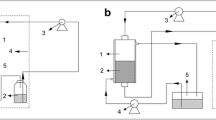Abstract
Cyclodextrin glucanotransferase (CGTase) fromThermoanaerobacter sp. was adsorbed on the ion exchange resin Amberlite IRA-900. The optimum conditions for the immobilization of the CGTase were pH 6.0 and 600 U CGTase/g resin, and the maximum yield of immobilization was around 63% on the basis of the amount ratio of the adsorbed enzyme to the initial amount in the solution. Immobilization of CGTase shifted the optimum temperature for the enzyme to produce transglycosylated xylitol from 70°C to 90°C and improved the thermal stability of immobilized CGTase, especially after the addition of soluble starch and calcium ions. Transglycosylated xylitol was continuously produced using immobilized CGTase in the column type packed bed reactor, and the operating conditions for maximum yield were 10% (w/v) dextrin (13 of the dextrose equivalent) as the glycosyl donor, 10% (w/v) xylitol as the glycosyl acceptor, 20 mL/h of medium flow rate, and 60°C. The maximum yield of transglycosylated xylitol and productivity were 25% and 7.82 g·L−1·h−1, respectively. The half-life of the immobilized CGTase in a column type packed bed reactor was longer than 30 days.
Similar content being viewed by others
References
Bar, A. (1986)Xylitol. pp. 185–216. In: L. O. Nabors and R. C. Gelardi (ed).Alternative Sweetners. Marcel Dekker Inc., New York, USA.
Kontiokari, T., M. Uhari, and M. Koskela (1995) Effect of xylitol on growth of nasopharyngeal bacteriain vitro.Antimicrob. Agents. Chemother. 39: 1820–1823.
Okada, S. (1987) Studies on cyclomaltodextrin glucanotransferase and coupling sugar.J. Jpn. Soc. Starch Sci. 34: 75–82.
Kitahata, S. and S. Okada (1976) Studies on cyclodextrin glycosyltransferase IV. Enzymatic synthesis of 3-O-α-D-glucopyranosyl-L-sorbose and 4-O-α-D-glucopyranosyl-D-xylose using cyclodextrin glycosyltransferase.J. Biochem. 79: 641–648.
Aga, H., M. Yoneyama, S. Sakai, and I. Yamamoto (1991) Synthesis of 2-O-α-D-glucopyranosyl L-ascorbic acid by cyclomaltodextrin glucanotransferase fromBacillus stearothermophilus.Agric. Biol. Chem. 55: 1751–1756.
Kometani, T., Y. Terada, T. Nishimura, H. Takii, and S. Okada (1994) Transglycosylation to hesperidin by cyclodextrin glucanotransferase from an alkalophilicBacillus: species and in alkaline pH and properties of hesperidin glycosides.Biosci. Biotech. Biochem. 58: 1990–1994.
Okada, S., S. Kitahata, M. Shiosaka, H. Bunya, M. Kubota, S. Sakai, and Y. Sujisaka (1991) Application of cyclodextrin glucanotransferase.Denpun Kagaku 38: 211–215.
Sato, M., T. Matsuo, N. Orita, and Y. Yagi (1991) Synthesis of novel sugars, oligoglucosyl-inositol, and their growth stimulating effect forBiffidobacterium.Biotechnol. Lett. 13: 69–74.
Sato, M., K. Nakamra, H. Nagano, Y. Yagi, and K. Koizumi (1992) Synthesis of glucosyl-inositol using a CGTase, isolation and characterization of positional isomers, and assimilation profiles for intestinal bacteria.Biotechnol. Lett. 14: 659–664.
Kim, T. K., D. C. Park, and Y. H. Lee (1997) Synthesis of glucosyl-sugar alcohols using cyclodextrin glucosyltransferase and structural identification of glucosyl-maltitol.J. Microbiol. Biotechnol. 7: 310–317.
Kim, T. K., D. C. Park, and Y. H. Lee (1998) Synthesis of transglycosylated xylitol using, cyclodextrin glucanotransferase and its stimulating effect on growth ofBiffidobacterium.Kor. J. Appl. Microbiol. Biotechnol. 26: 442–449.
Nakamura, N. and K. Horikoshi (1977) Production of schardinger β-dextrin by soluble and immobilized cyclodextrin glycosyltransferase of an alkalophilicBacillus sp.Biotechnol. Bioeng. 19: 87–99.
Kato, T. and K. Horikoshi (1984) Immobilized cyclodextrin glucanotransferase of an alkalophilicBacillus sp. No. 38-2.Biotechnol. Bioeng. 26: 595–598.
Hitoshi, H., K. Hara, N. Kuwahara, S. Sakai, and N. Yamamoto (1986) The continuous reaction of cyclodextrin formation by the column method using the immobilized enzyme on ion exchange resins.J. Jpn., Soc. Starch Sci. 33: 29–33.
Okada, T., M. Ito, and K. Hibino (1994) Immobilization of cyclodextrin glucanotransferase on capillary membrane.Ferment. Bioeng. 77: 259–263.
Lee, Y. H., S. H. Lee, and H. D. Shin (1991) Evaluation of immobilization methods for cyclodextrin glucanotransferase and characterization of its enzymatic properties.J. Microbiol. Biotechnol. 1: 54–62.
Lee, Y. H., S. H. Lee, and H. D. Shin (1991) Performance of column type bioreactor packed with immobilized cyclodextrin glucanotransferase for cyclodextrin production.J. Microbiol. Biotechnol. 1: 63–69.
In, M. J., D. C. Kim, H. J. Chae, K. S. Choi, and M. H. Kim (1997) Immobilization of cyclodextrin glucanotransferase and its reaction characteristics regarding transglycosylated stevioside production.Kor. J. Appl. Microbiol. Biotechnol. 25: 305–310.
Akimaru, K., T. Yagi, and S. Yamamoto (1991) Purification and properties ofBacillus coagulans cyclodextrin glucanotransferase.J. Ferment. Bioeng. 71: 322–328.
Kitahata, S. and S. Okada (1974) Action of cyclodextrin glucanotransferase fromBacillus megatrium strain No. 5 on starch.Agri. Biol. Chem. 38: 2413–2417.
Bradford, M. M. (1976) A rapid and sensitive method for the quantitation of microgram quantities of protein utilizing the principle of protein-dye binding.Anal. Biochem. 72: 248–254.
Norman, B. E. and S. T. Jorgensen (1992)Thermoanaerobacter sp. CGTase: its properties and application,Deupun Kagaku 39: 99–106.
Knegtel, R. M. A., R. D. Wind, H. J. Rozeroom, K. H. Kalk, R. M. Buitelaar, L. Dijkhuizen, and B. W. Dijkstra (1996) Crystal structure at 2.3Å resolution and revised nucleotide sequence of the thermostable cyclodextrin glycosyltransferase fromThermoanaerobacterium thermosulfurigenes EM1.J. Mol. Biol. 256: 611–622.
Wind, R. D., W. Liebl, R. M. Buitelaar, D. Penniga, A. Spreinat, L. Dijkhuizen, and H. Bahl (1995) Cyclodextrin formation by thermostable α-amylase ofThermoanaerobacterium thermosulfurigenes EM1 and reclassify-cation of the enzyme as a cyclodextrin glucosyltrans-ferase.Appl. Environ. Microbiol. 61: 1257–1265.
Kobayashi, S., N. Watanabe, K. Nakashima, M. Shiota, and T. Yatake (1995) Action of cyclodextrin producing enzyme (CGTase) and diglucosyl-cyclodextrin.J. Appl. Glycosci. 42: 203–210.
Mattsson, P., T. Korpela, S. Paavilainen, and M. Mäkelä (1991) Enhanced conversion of starch to cyclodextrin in ethanolic solutions byBacillus circulans varalkalophilus cyclomaltodextrin glucanotransferase.Appl. Biochem. Biotechnol. 30: 17–28.
Author information
Authors and Affiliations
Corresponding author
Rights and permissions
About this article
Cite this article
Kim, PS., Shin, HD., Park, JK. et al. Immobilization of cyclodextrin glucanotransferase on amberlite IRA-900 for biosynthesis of transglycosylated xylitol. Biotechnol. Bioprocess Eng. 5, 174–180 (2000). https://doi.org/10.1007/BF02936590
Received:
Accepted:
Issue Date:
DOI: https://doi.org/10.1007/BF02936590




